brake light OPEL CORSA F 2020 Manual user
[x] Cancel search | Manufacturer: OPEL, Model Year: 2020, Model line: CORSA F, Model: OPEL CORSA F 2020Pages: 229, PDF Size: 21.14 MB
Page 9 of 229

In brief71Power windows .....................23
2 Exterior mirrors .....................21
3 Side air vents ........................ 96
4 Turn lights, headlight
flash, low / high beam ...........85
Parking lights ........................ 86
Buttons for Driver
Information Centre ................73
5 Cruise control .....................120
Adaptive cruise control .......124
Speed limiter ....................... 122
Heated steering wheel ..........55
6 Instruments ........................... 63
Driver Information Centre ...... 73
7 Infotainment controls
8 Windscreen wiper and
washer, rear wiper and
washer ................................. 56
9 Power button ....................... 100
10 Central locking system .........12
11 Centre air vents .................... 96
12 Controls for Info Display
operation .............................. 7513Anti-theft alarm system
status LED ........................... 19
14 Info Display .......................... 75
15 Hazard warning flashers ......85
16 Glovebox .............................. 47
17 Climate control system ......... 90
18 USB charging port ................ 59
19 Power outlet .......................... 59
20 Parking assist / Advanced
parking assist .....................138
Lane keep assist .................152
Stop start system ................103
Electronic Stability Control
and Traction Control ...........118
21 Manual transmission ..........114
Automatic transmission ......110
22 Manual parking brake ........115
Electric parking brake ........115
23 Ignition switch ....................... 99
24 Steering wheel adjustment ..55
25 Horn ..................................... 56
26 Fuse box ............................ 176
27 Bonnet release lever ..........16328Light switch .......................... 80
Headlight range
adjustment ........................... 82
Front / rear fog lights ............85
Instrument illumination .........87
Page 56 of 229
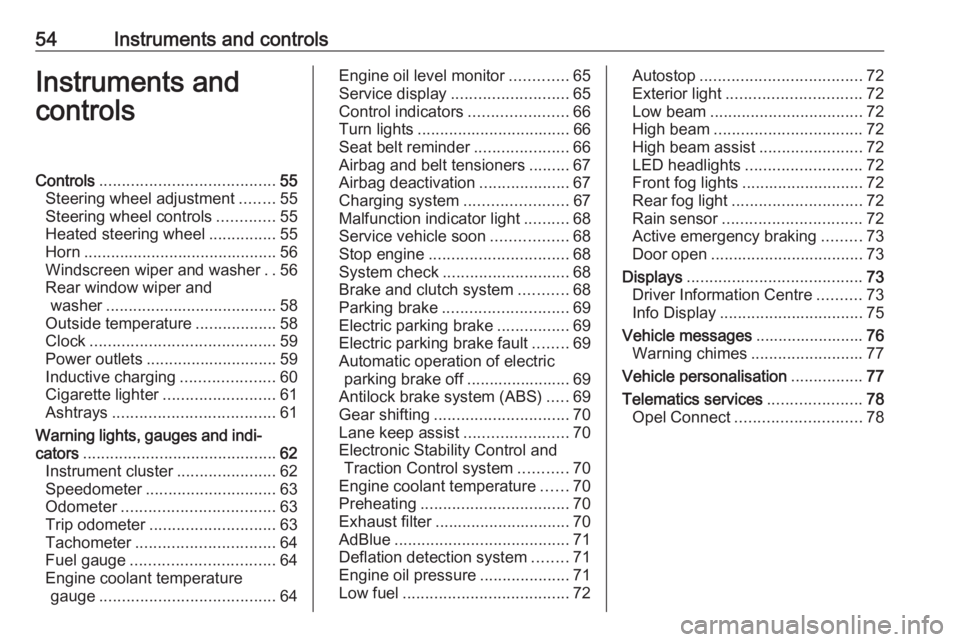
54Instruments and controlsInstruments and
controlsControls ....................................... 55
Steering wheel adjustment ........55
Steering wheel controls .............55
Heated steering wheel ...............55
Horn ........................................... 56
Windscreen wiper and washer ..56
Rear window wiper and washer ...................................... 58
Outside temperature ..................58
Clock ......................................... 59
Power outlets ............................. 59
Inductive charging .....................60
Cigarette lighter ......................... 61
Ashtrays .................................... 61
Warning lights, gauges and indi‐ cators ........................................... 62
Instrument cluster ......................62
Speedometer ............................. 63
Odometer .................................. 63
Trip odometer ............................ 63
Tachometer ............................... 64
Fuel gauge ................................ 64
Engine coolant temperature gauge ....................................... 64Engine oil level monitor.............65
Service display .......................... 65
Control indicators ......................66
Turn lights .................................. 66
Seat belt reminder .....................66
Airbag and belt tensioners .........67
Airbag deactivation ....................67
Charging system .......................67
Malfunction indicator light ..........68
Service vehicle soon .................68
Stop engine ............................... 68
System check ............................ 68
Brake and clutch system ...........68
Parking brake ............................ 69
Electric parking brake ................69
Electric parking brake fault ........69
Automatic operation of electric parking brake off ....................... 69
Antilock brake system (ABS) .....69
Gear shifting .............................. 70
Lane keep assist .......................70
Electronic Stability Control and Traction Control system ...........70
Engine coolant temperature ......70
Preheating ................................. 70
Exhaust filter .............................. 70
AdBlue ....................................... 71
Deflation detection system ........71
Engine oil pressure ....................71
Low fuel ..................................... 72Autostop.................................... 72
Exterior light .............................. 72
Low beam .................................. 72
High beam ................................. 72
High beam assist .......................72
LED headlights .......................... 72
Front fog lights ........................... 72
Rear fog light ............................. 72
Rain sensor ............................... 72
Active emergency braking .........73
Door open .................................. 73
Displays ....................................... 73
Driver Information Centre ..........73
Info Display ................................ 75
Vehicle messages ........................76
Warning chimes .........................77
Vehicle personalisation ................77
Telematics services .....................78
Opel Connect ............................ 78
Page 64 of 229
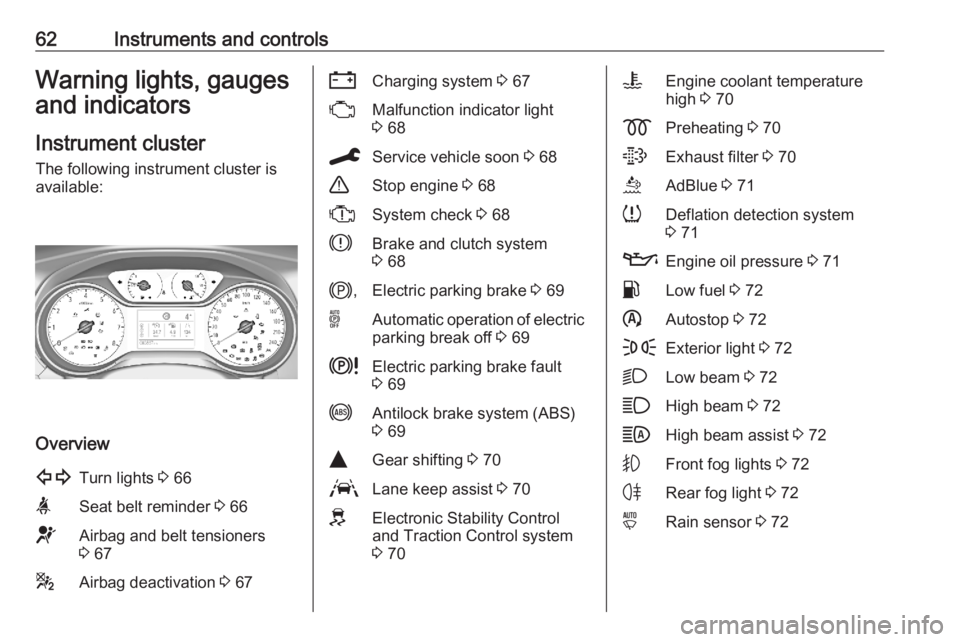
62Instruments and controlsWarning lights, gauges
and indicators
Instrument cluster
The following instrument cluster is
available:
Overview
1Turn lights 3 66aSeat belt reminder 3 66dAirbag and belt tensioners
3 67gAirbag deactivation 3 67SCharging system 3 67WMalfunction indicator light
3 68CService vehicle soon 3 68+Stop engine 3 68XSystem check 3 68hBrake and clutch system
3 68j ,Electric parking brake 3 69oAutomatic operation of electric
parking break off 3 69kElectric parking brake fault
3 69iAntilock brake system (ABS)
3 69YGear shifting 3 70LLane keep assist 3 70JElectronic Stability Control
and Traction Control system
3 70VEngine coolant temperature
high 3 70zPreheating 3 70tExhaust filter 3 70uAdBlue 3 71qDeflation detection system
3 71TEngine oil pressure 3 71rLow fuel 3 72nAutostop 3 72FExterior light 3 72DLow beam 3 72AHigh beam 3 72BHigh beam assist 3 72GFront fog lights 3 72HRear fog light 3 72yRain sensor 3 72
Page 70 of 229
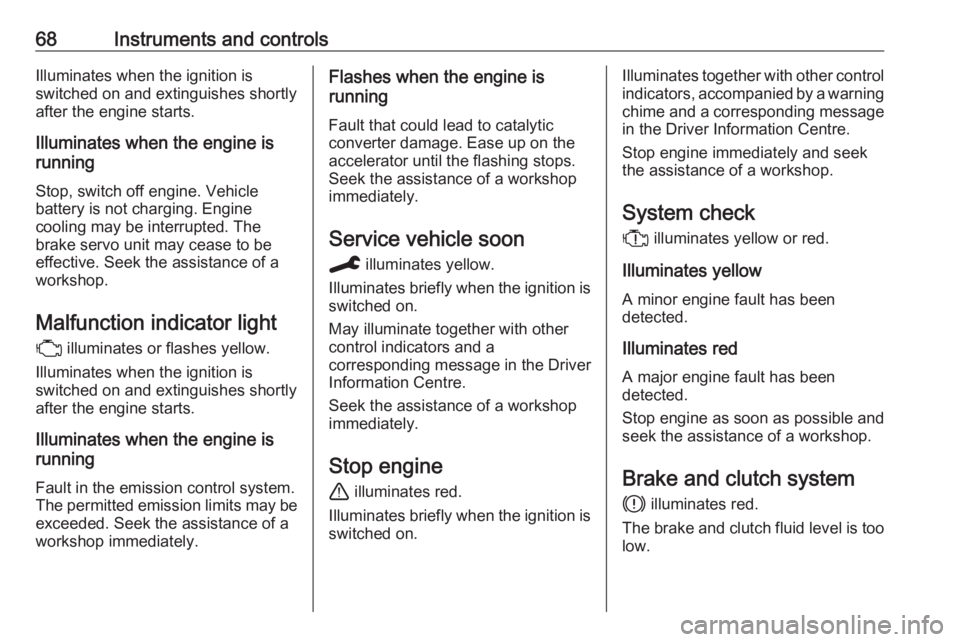
68Instruments and controlsIlluminates when the ignition is
switched on and extinguishes shortly
after the engine starts.
Illuminates when the engine is
running
Stop, switch off engine. Vehicle
battery is not charging. Engine
cooling may be interrupted. The
brake servo unit may cease to be
effective. Seek the assistance of a
workshop.
Malfunction indicator light W illuminates or flashes yellow.
Illuminates when the ignition is
switched on and extinguishes shortly
after the engine starts.
Illuminates when the engine is
running
Fault in the emission control system. The permitted emission limits may be exceeded. Seek the assistance of a
workshop immediately.Flashes when the engine is
running
Fault that could lead to catalytic converter damage. Ease up on the
accelerator until the flashing stops.
Seek the assistance of a workshop
immediately.
Service vehicle soon C illuminates yellow.
Illuminates briefly when the ignition is
switched on.
May illuminate together with other
control indicators and a
corresponding message in the Driver
Information Centre.
Seek the assistance of a workshop
immediately.
Stop engine
+ illuminates red.
Illuminates briefly when the ignition is
switched on.Illuminates together with other control indicators, accompanied by a warning chime and a corresponding message
in the Driver Information Centre.
Stop engine immediately and seek
the assistance of a workshop.
System check X illuminates yellow or red.
Illuminates yellow
A minor engine fault has been
detected.
Illuminates red A major engine fault has been
detected.
Stop engine as soon as possible and seek the assistance of a workshop.
Brake and clutch system
h illuminates red.
The brake and clutch fluid level is too
low.
Page 74 of 229
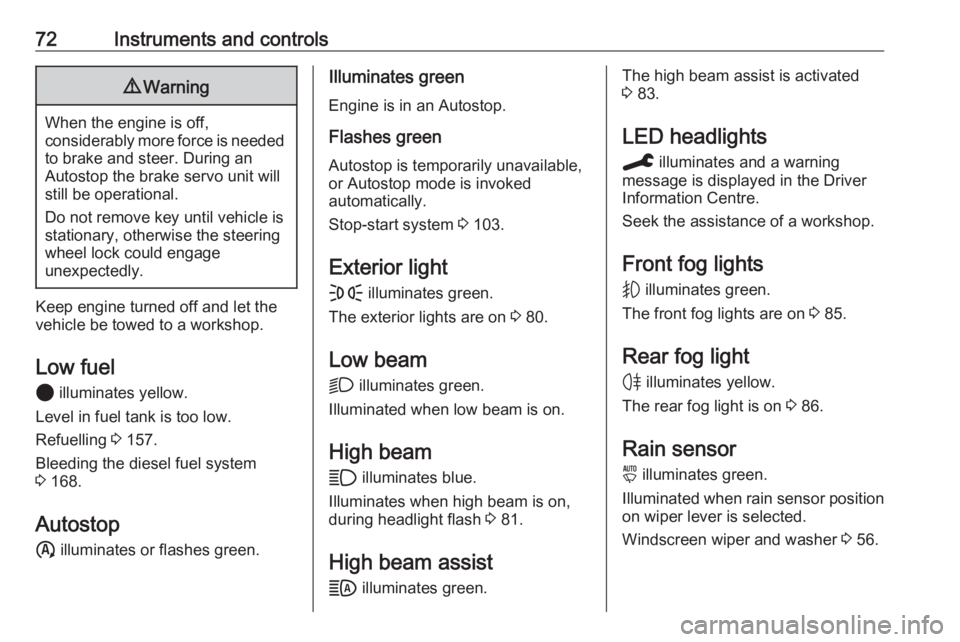
72Instruments and controls9Warning
When the engine is off,
considerably more force is needed
to brake and steer. During an
Autostop the brake servo unit will still be operational.
Do not remove key until vehicle is stationary, otherwise the steeringwheel lock could engage
unexpectedly.
Keep engine turned off and let the
vehicle be towed to a workshop.
Low fuel 2 illuminates yellow.
Level in fuel tank is too low.
Refuelling 3 157.
Bleeding the diesel fuel system
3 168.
Autostop n illuminates or flashes green.
Illuminates green
Engine is in an Autostop.
Flashes green
Autostop is temporarily unavailable,
or Autostop mode is invoked
automatically.
Stop-start system 3 103.
Exterior light
F illuminates green.
The exterior lights are on 3 80.
Low beam D illuminates green.
Illuminated when low beam is on.
High beam
A illuminates blue.
Illuminates when high beam is on,
during headlight flash 3 81.
High beam assist
B illuminates green.The high beam assist is activated
3 83.
LED headlights C illuminates and a warning
message is displayed in the Driver
Information Centre.
Seek the assistance of a workshop.
Front fog lights
G illuminates green.
The front fog lights are on 3 85.
Rear fog light H illuminates yellow.
The rear fog light is on 3 86.
Rain sensor y illuminates green.
Illuminated when rain sensor position on wiper lever is selected.
Windscreen wiper and washer 3 56.
Page 79 of 229
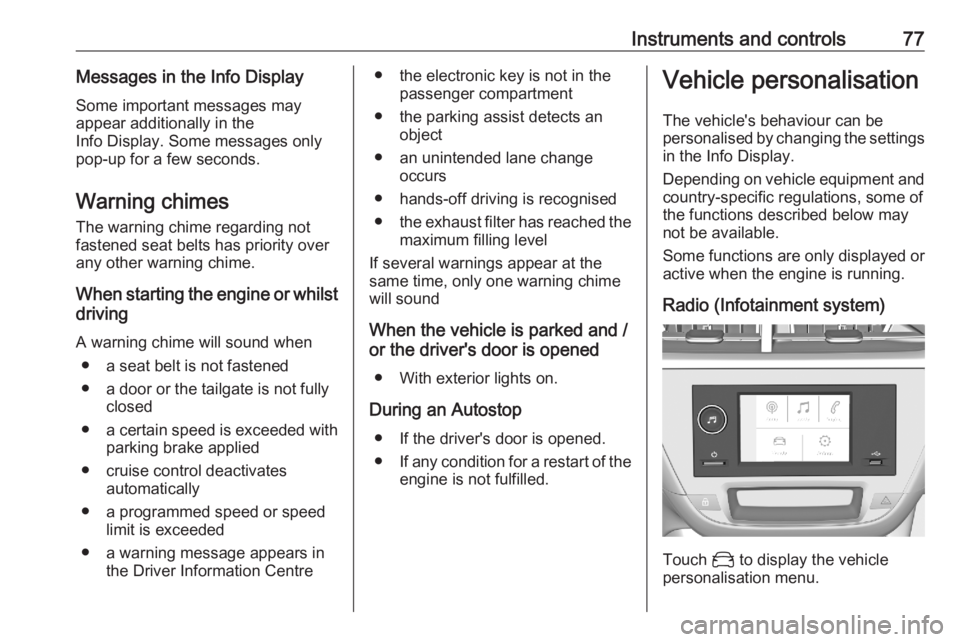
Instruments and controls77Messages in the Info DisplaySome important messages may
appear additionally in the
Info Display. Some messages only
pop-up for a few seconds.
Warning chimes The warning chime regarding not
fastened seat belts has priority over
any other warning chime.
When starting the engine or whilst driving
A warning chime will sound when ● a seat belt is not fastened
● a door or the tailgate is not fully closed
● a certain speed is exceeded with
parking brake applied
● cruise control deactivates automatically
● a programmed speed or speed limit is exceeded
● a warning message appears in the Driver Information Centre● the electronic key is not in the passenger compartment
● the parking assist detects an object
● an unintended lane change occurs
● hands-off driving is recognised ● the exhaust filter has reached the
maximum filling level
If several warnings appear at the
same time, only one warning chime
will sound
When the vehicle is parked and /
or the driver's door is opened
● With exterior lights on.
During an Autostop ● If the driver's door is opened.
● If any condition for a restart of the
engine is not fulfilled.Vehicle personalisation
The vehicle's behaviour can be
personalised by changing the settings
in the Info Display.
Depending on vehicle equipment and
country-specific regulations, some of
the functions described below may
not be available.
Some functions are only displayed or
active when the engine is running.
Radio (Infotainment system)
Touch _ to display the vehicle
personalisation menu.
Page 104 of 229
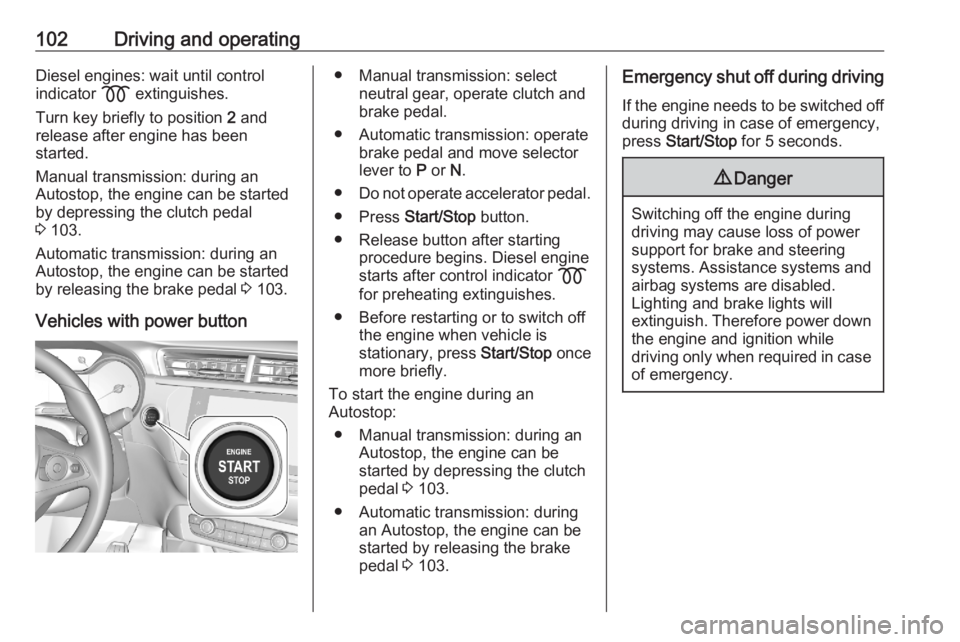
102Driving and operatingDiesel engines: wait until control
indicator z extinguishes.
Turn key briefly to position 2 and
release after engine has been
started.
Manual transmission: during an
Autostop, the engine can be started
by depressing the clutch pedal
3 103.
Automatic transmission: during an
Autostop, the engine can be started
by releasing the brake pedal 3 103.
Vehicles with power button● Manual transmission: select neutral gear, operate clutch and
brake pedal.
● Automatic transmission: operate brake pedal and move selector
lever to P or N.
● Do not operate accelerator pedal.
● Press Start/Stop button.
● Release button after starting procedure begins. Diesel engine
starts after control indicator z
for preheating extinguishes.
● Before restarting or to switch off the engine when vehicle is
stationary, press Start/Stop once
more briefly.
To start the engine during an
Autostop:
● Manual transmission: during an Autostop, the engine can be
started by depressing the clutch
pedal 3 103.
● Automatic transmission: during an Autostop, the engine can be
started by releasing the brake pedal 3 103.Emergency shut off during driving
If the engine needs to be switched offduring driving in case of emergency,
press Start/Stop for 5 seconds.9Danger
Switching off the engine during
driving may cause loss of power
support for brake and steering
systems. Assistance systems and
airbag systems are disabled.
Lighting and brake lights will
extinguish. Therefore power down the engine and ignition while
driving only when required in case of emergency.
Page 118 of 229
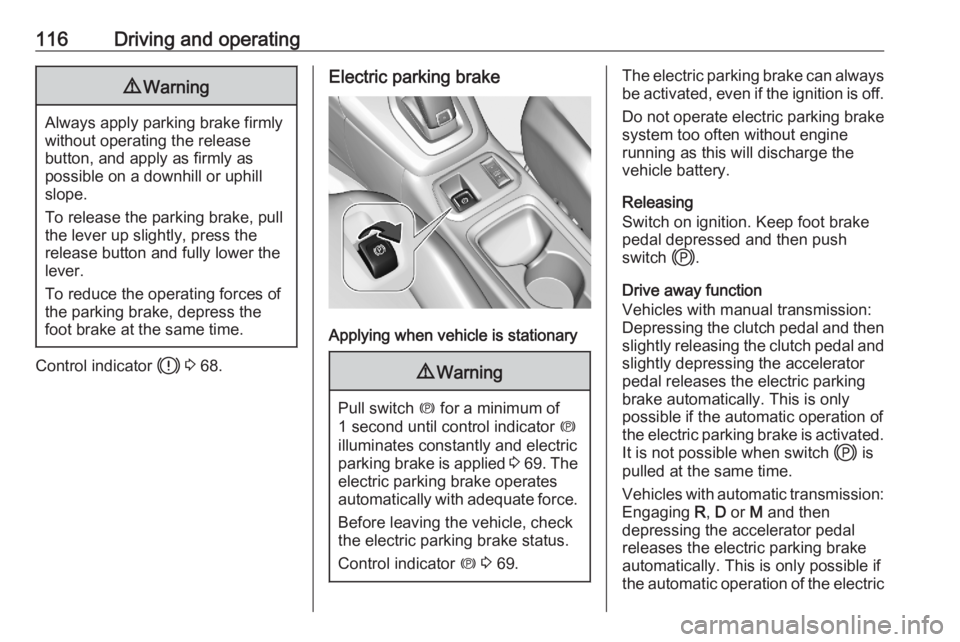
116Driving and operating9Warning
Always apply parking brake firmly
without operating the release
button, and apply as firmly as
possible on a downhill or uphill
slope.
To release the parking brake, pull
the lever up slightly, press the
release button and fully lower the
lever.
To reduce the operating forces of
the parking brake, depress the
foot brake at the same time.
Control indicator h 3 68.
Electric parking brake
Applying when vehicle is stationary
9 Warning
Pull switch m for a minimum of
1 second until control indicator m
illuminates constantly and electric
parking brake is applied 3 69 . The
electric parking brake operates automatically with adequate force.
Before leaving the vehicle, check
the electric parking brake status.
Control indicator m 3 69.
The electric parking brake can always
be activated, even if the ignition is off.
Do not operate electric parking brake
system too often without engine
running as this will discharge the
vehicle battery.
Releasing
Switch on ignition. Keep foot brake
pedal depressed and then push
switch j.
Drive away function
Vehicles with manual transmission:
Depressing the clutch pedal and then slightly releasing the clutch pedal and
slightly depressing the accelerator
pedal releases the electric parking
brake automatically. This is only
possible if the automatic operation of
the electric parking brake is activated. It is not possible when switch j is
pulled at the same time.
Vehicles with automatic transmission: Engaging R, D or M and then
depressing the accelerator pedal
releases the electric parking brake
automatically. This is only possible if
the automatic operation of the electric
Page 127 of 229

Driving and operating125
It uses radar and camera sensors to
detect the vehicles ahead. If no
vehicle is detected in the driving path, the adaptive cruise control will
behave like a conventional cruise
control.
The adaptive cruise control
automatically decelerates the vehicle
when approaching a slower moving
vehicle. It then adjusts the vehicle
speed to follow the vehicle ahead at
the selected following distance. The
vehicle speed increases or decreases
to follow the vehicle ahead, but will
not exceed the set speed. It may
apply limited braking with activated
brake lights.
If the vehicle ahead accelerates or
changes lane, the adaptive cruise
control progressively accelerates the
vehicle to return to the stored set
speed. If the driver operates the turn
lights to overtake a slower vehicle, the
adaptive cruise control allows the
vehicle to temporarily approach the
vehicle ahead to help passing it.
However, the set speed will never be
exceeded.
The adaptive cruise control can store
set speeds over 30 km/h for manual
transmission. If the vehicle ahead is
moving too slowly and the selected
following distance cannot be
maintained anymore, a warning
chime is given and a message is
displayed in the Driver Information
Centre. The message prompts the
driver to take back control of the
vehicle. On vehicles with automatic
transmission, the system can brake
the vehicle until a full stop.9 Warning
The complete driver attention is
always required while driving with adaptive cruise control. The driver stays fully in control of the vehicle
because the brake pedal, the
accelerator pedal and the button
Ñ have priority over any adaptive
cruise control operation.
Switching on the system
Press w.
w is indicated in the Driver
Information Centre. The system is still not active.
Page 132 of 229
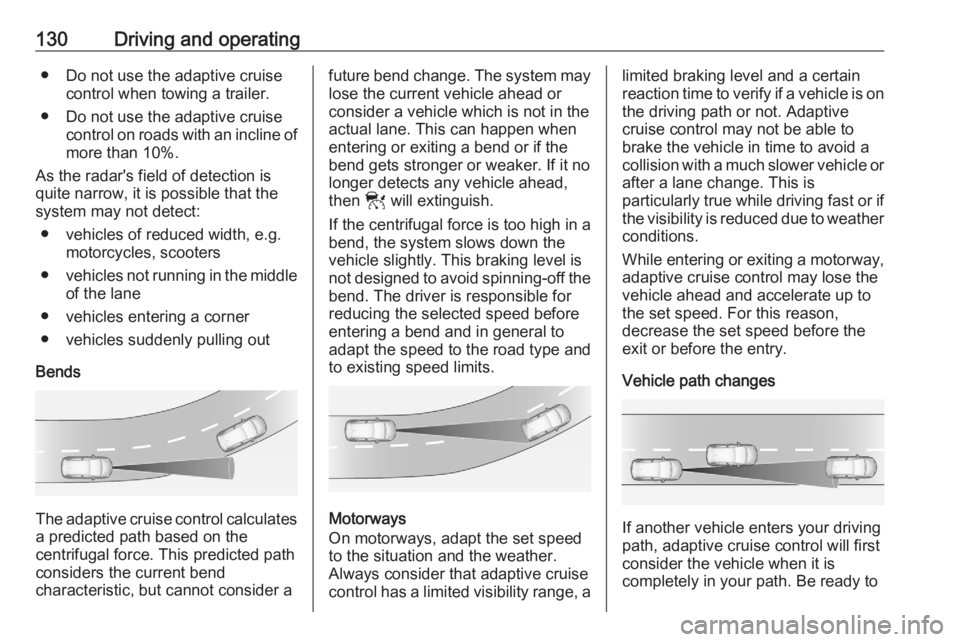
130Driving and operating● Do not use the adaptive cruisecontrol when towing a trailer.
● Do not use the adaptive cruise control on roads with an incline of
more than 10%.
As the radar's field of detection is
quite narrow, it is possible that the
system may not detect:
● vehicles of reduced width, e.g. motorcycles, scooters
● vehicles not running in the middle
of the lane
● vehicles entering a corner
● vehicles suddenly pulling out
Bends
The adaptive cruise control calculates
a predicted path based on the
centrifugal force. This predicted path
considers the current bend
characteristic, but cannot consider a
future bend change. The system may lose the current vehicle ahead or
consider a vehicle which is not in the
actual lane. This can happen when
entering or exiting a bend or if the
bend gets stronger or weaker. If it no
longer detects any vehicle ahead,
then w will extinguish.
If the centrifugal force is too high in a
bend, the system slows down the
vehicle slightly. This braking level is
not designed to avoid spinning-off the
bend. The driver is responsible for
reducing the selected speed before
entering a bend and in general to
adapt the speed to the road type and
to existing speed limits.
Motorways
On motorways, adapt the set speed
to the situation and the weather.
Always consider that adaptive cruise
control has a limited visibility range, a
limited braking level and a certain
reaction time to verify if a vehicle is on
the driving path or not. Adaptive
cruise control may not be able to
brake the vehicle in time to avoid a
collision with a much slower vehicle or after a lane change. This is
particularly true while driving fast or if the visibility is reduced due to weather
conditions.
While entering or exiting a motorway,
adaptive cruise control may lose the
vehicle ahead and accelerate up to
the set speed. For this reason,
decrease the set speed before the
exit or before the entry.
Vehicle path changes
If another vehicle enters your driving
path, adaptive cruise control will first
consider the vehicle when it is
completely in your path. Be ready to